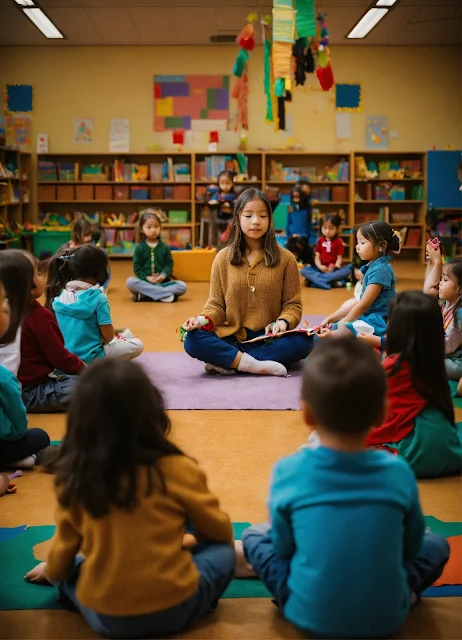In today's dynamic world, equipping our children with the tools to navigate life's challenges is more crucial than ever. One of the most powerful gifts we can give them is the ability to cultivate emotional resilience. This blog delves into the profound impact of nurturing emotional resilience in children and provides insightful strategies for parents, educators, and caregivers.
Understanding Emotional Resilience
At its core, emotional resilience empowers children to bounce back from adversity, embrace change, and thrive in the face of challenges. It encompasses skills such as adaptability, self-regulation, optimism, and perseverance, all of which are fundamental for their personal growth and well-being.
The Building Blocks of Resilience
Explore the key factors that contribute to building emotional resilience in children. From fostering strong relationships and providing a nurturing environment to encouraging problem-solving skills and promoting a positive mindset, each aspect plays a crucial role in shaping their resilience.
Practical Strategies for Parents and Caregivers
Empower parents and caregivers with actionable strategies to nurture emotional resilience in children. From fostering open communication and teaching coping mechanisms to celebrating small victories and modeling resilience themselves, these strategies lay a solid foundation for children's emotional well-being.
The Role of Education in Resilience
Delve into the educational approaches that support the development of emotional resilience. Highlight the importance of social-emotional learning (SEL) programs, mindfulness practices, and creating inclusive school environments that prioritize mental health and resilience.
Embracing Challenges as Opportunities
Shift the narrative around challenges by showcasing how they can be transformative experiences that build resilience. Share stories of resilience, emphasizing the lessons learned and the growth that stems from facing and overcoming obstacles.
Cultivating a Resilient Mindset
Encourage a resilient mindset in children by promoting self-awareness, empathy, gratitude, and a growth mindset. These foundational elements empower them to navigate life's complexities with resilience, compassion, and a sense of purpose.
Supporting Children's Mental Health
Highlight the vital connection between emotional resilience and mental health. Advocate for early intervention, open conversations about mental well-being, and accessing professional support when needed, fostering a culture of proactive mental health care.
Celebrating Every Step Forward
Emphasize the importance of celebrating every step forward, no matter how small. Recognizing and acknowledging children's efforts, progress, and resilience cultivates a sense of confidence, self-worth, and resilience that propels them forward in life.
Empowering the Leaders of Tomorrow
Ultimately, nurturing emotional resilience in children is about empowering them to become resilient, empathetic, and adaptable leaders of tomorrow. By investing in their emotional well-being today, we pave the way for a brighter, more resilient future for generations to come.
This comprehensive exploration of nurturing emotional resilience in children serves as a guiding light for anyone passionate about fostering a generation of resilient, compassionate, and empowered individuals poised to thrive in a rapidly changing world.
Sam's Journey: Cultivating Emotional Resilience in Childhood
Once upon a time in a bustling city, there lived a young boy named Sam. Sam was known for his curious nature and boundless energy. However, like all children, Sam encountered his fair share of challenges and setbacks as he navigated the complexities of growing up.
One day, Sam faced a particularly tough situation at school. He didn't do as well as he had hoped on a test, and some of his classmates teased him about it. Feeling a mix of disappointment, embarrassment, and frustration, Sam found himself overwhelmed with emotions.
Fortunately, Sam had been learning about emotional resilience both at home and in school. His parents and teachers had been emphasizing the importance of staying positive, facing challenges head-on, and learning from mistakes. Armed with these lessons, Sam approached the situation with a resilient mindset.
Instead of dwelling on his disappointment, Sam took a deep breath and reminded himself that setbacks were a natural part of learning and growing. He reached out to his teacher for guidance on how to improve his understanding of the subject and practiced self-compassion by acknowledging that everyone makes mistakes sometimes.
Throughout his journey, Sam encountered various obstacles, from friendship conflicts to academic struggles. Each time, he applied the principles of emotional resilience he had learned. He sought support from trusted adults, practiced mindfulness to stay focused, and embraced a growth mindset that viewed challenges as opportunities for growth.
As Sam continued to cultivate his emotional resilience, he noticed positive changes in himself. He became more confident in handling difficult situations, developed a deeper sense of empathy and understanding toward others, and maintained a positive outlook even in the face of adversity.
One day, during a school project that required teamwork and creativity, Sam's resilience shone brightly. He listened actively to his teammates' ideas, contributed his own thoughts with confidence, and remained flexible when unexpected challenges arose. Together, they successfully completed the project, showcasing resilience, collaboration, and perseverance.
Through Sam's journey, we learn that cultivating emotional resilience in childhood is a transformative process. It equips children like Sam with the tools and mindset to navigate life's ups and downs with courage, resilience, and empathy. As Sam continues to grow and learn, his journey inspires others to embrace resilience as a fundamental pillar of personal growth and well-being.











Comments
Post a Comment